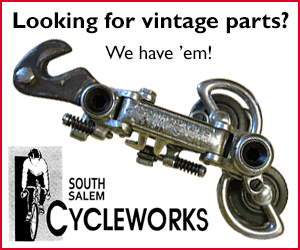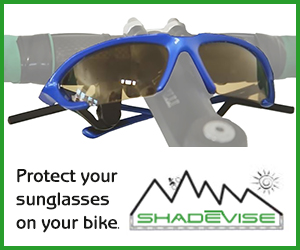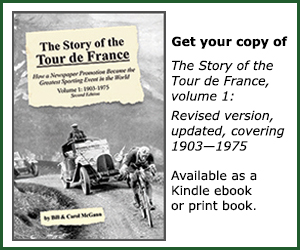
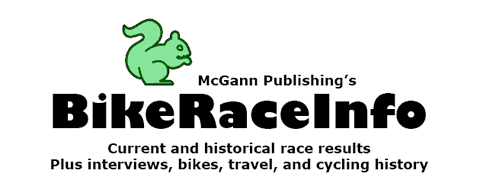
David L. Stanley
Seasons of the Bike, Part 2:
The Vuelta a España and Fall Racing
David Stanley is an experienced cycling writer. His work has appeared in Velo, Velo-news.com, Road, Peloton, and the late, lamented Bicycle Guide (my favorite all-time cycling magazine). Here's his Facebook page. He is also a highly regarded voice artist with many audiobooks to his credit, including McGann Publishing's The Olympics' 50 Craziest Stories and Cycling Heroes.

David L Stanley
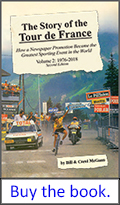
Bill and Carol McGann's book The Story of the Tour de France, Vol 2: 1976 - 2018 is available as an audiobook here. For the print and Kindle eBook versions, just click on the Amazon link on the right.
David Stanley writes:
The Vuelta a Espana started this past Saturday, August 22. The maillot rojo replaced the maillot jaune. Tempranillo replaced Côtes du Rhône. While there is no race up the punishing Alto de l’Angliru in this year’s Vuelta, the men of the Vuelta do tackle the Ermita de Alba. Stage 16’s most dangerous climb is merely 7 kilometers, half the length of its more famous neighbor, but this never-before-scaled-in-the-Vuelta climb averages 11 percent with several pitches of 30 percent. That’s a blue square, intermediate level ski run at most ski resorts. Steep. Very steep on a bike.

It's a red jersey for the race leader at the Vuelta
As the Vuelta starts less than thirty days after the Tour de France, in an average year, few of the Tour de France’s stars take on the Spanish race. But in a rare treat, this year’s Tour podium; champion Chris Froome, Nairo Quintana, and his sidekick Valverde were at the start. 2010 Vuelta champion Nibali was also present in Porto Banus for the 7.4 km team time trial that kicked off this year’s race.

Alejandro Valverde at the start of Vuelta stage 3
The Super Bowl is over, and the Vuelta gives riders a chance to swing for the fences in a way that they cannot in the media scrum that is the Tour. Racing in the fall, the Vuelta, the World’s, the Giro della Lombardia give riders a chance to reboot their seasons. It is one more chance to impress with one grand exploit.
Racing in the fall excites, but it also takes me back to my own racing days. As a run-of-the-mill category II rider in the 1980s and early '90s, by the time late August rolled around, I was as fit and as fast as I was going to get. You might remember that in those days, the cycling excitement of fall was focused on the World Championships, as the Vuelta had an April start until 1995. Here in the Midwest, Labor Day weekend was our focus. There were two races in Windsor, Ontario, dead in the heart of Little Italy, followed by another in Detroit, dead in the heart of Little Belgium. The DeBaets-Devos Race started outside Detroit’s famed Cadieux Café, home to steamed mussels, frites, 40 kinds of Belgian beers, and a selection of exquisite Belgian chocolates if one knew enough to ask for them. Once into September, we would continue to race, but speedwork and intervals and structured training went right out the window.
In fall, I rode for fun. In Flint, Michigan, riding for fun meant I was lucky enough to ride with my friend Robert Hoornaert. Robert was a Belgian ex-pat, thirty years my senior, who had raced semi-professionally in the old country. After the war, he moved to the States to find work. By the time we met, Robert was retired and we would ride together several mornings each week.
Robert rode a French-made bicycle, a Follis. It had an interesting assortment of parts; a Brooks leather saddle, a push-rod Campy Valentino front changer, a nylon Simplex rear changer for his five speed freewheel, and Mafac centerpulls. Robert usually wore a two tone woolen jersey with collar flaps, a la Fausto Coppi. Under the jersey, he always wore a white undershirt, a la Marlon Brando as Stanley Kowalski screaming “STELLA!!” But in a nod to modernity, and perhaps comfort, he generally wore lycra shorts. On his feet, he wore Detto Pietro 74s, with adjustable cleats. He said he had nailed on plenty of cleats in his lifetime, and had no desire to do so again.

A classic Follis bike from the early 1970s
Robert Hoornaert on a bike was a thing of beauty. He may have been sixty-five when we rode together, but once his leg went over that top tube, the man was thirty years younger. He had classic Belgian looks; lean, with a hooked nose and jet black hair. His hair was slicked back, rarely a helmet, and it looked as coiffed at the end of the ride as it did at the start. His set-up was 1950s-era perfect, extended but not stretched, and his perch on the saddle allowed just enough extension to spin the pedals, toes slightly down, with no wasted effort. On the flatlands of mid-Michigan, Robert had no need to shift gears. To speed up, Robert upped the RPMs. On a bicycle, my friend Robert was a prince.
As we rode, we talked. Of food and beer, wives and girlfriends, and always, cycling. One morning, I gathered some courage and asked him about his cobbled together bike.
“Robert, you had a good job for years. You love to ride. Why don’t you treat yourself a little?”
“Dave, you know, I’m an old man. It’s not about the bike I ride. It’s that I can still ride the bike.”
“But you raced in Europe,” I said. “And here you are riding a bike you put together from a spare parts bin? I don’t get it.”
“Well, this bike is a lot better than anything I raced on back home. Heh, after the war, you were lucky just to have a bike.”
Belgians use a guttural ‘heh’ the way Canadians use ‘eh.’
“If you didn’t have a bike, then all you could do, heh, was play soccer. When something broke, you figured out how to fix it. When you got a flat, you patched it. And when it flatted again, you patched it again.”
“Nobody had any money, heh? If you made a couple of pennies, it went home to mom. Even my rich friends, the friends who maybe had some pocket change, they didn’t have anything. You hear how bad it was here during the war? Well, Europe was ten times, a hundred times worse. In the States, there was rationing, heh? In Europe, there wasn’t even anything to ration. Nobody had anything.”
“So, when I think about a new bike…”
He shrugged, a shrug that would have looked at home in la France Profonde.
Robert never missed a local race. We drove together only once, to a circuit race in Waterford in late September. I had already gone back to my fulltime job and had decided that this would be my last race of the season. The race was a 1.5 mile circuit at a sports car course. No free lap. No follow vehicles. You flat, and you roll to the start/finish for a spare, and from there, you chase.
Or quit.
Towards the end of the day, I flatted my rear. I was ready to quit. I’d had enough. Unbeknownst to me, Robert had pumped up my spare set of wheels and was walking the course in reverse. Not far from where I flatted, I spied Robert, waving a wheel in the air. I rolled up and straddled my bike.
“What’re you doing?” I asked him as he hoisted the back end of my bike in the air and started to change my wheel.
“You gotta chase, Dave. You gotta chase hard!! Get back up there!” he said.
“Robert…”
I started to say I was done for the day.
“You go full gas three laps, Dave. You don’t get back on, then you quit. 5 miles only. Let’s go!!”
With that, Robert Hoornaert pushed on a slightly tired, slightly lazy bike racer back towards the group far ahead. He pushed hard. I jumped. I chased.
A small group of favorites got away soon after I started my chase back. The peloton slowed. Cheered on by Robert, I chased harder and got back on. In the field sprint for about tenth place, I crashed coming out the final turn, 150 meters from the end.
I’d never done that before, to chase and catch back on. I took the next week off to heal. Fired up by Robert Hoornaert’s enthusiasm, that fall race in Waterford wasn’t the end of my season. It was the beginning.
Next on The Seasons of the Bike, Winter: the season doesn't truly end.
- Visit the McGann Facebook page
- On the Twitter, you can follow BikeRaceInfo here.
- Stanley’s Twitter is here. I tweet early, and often.




